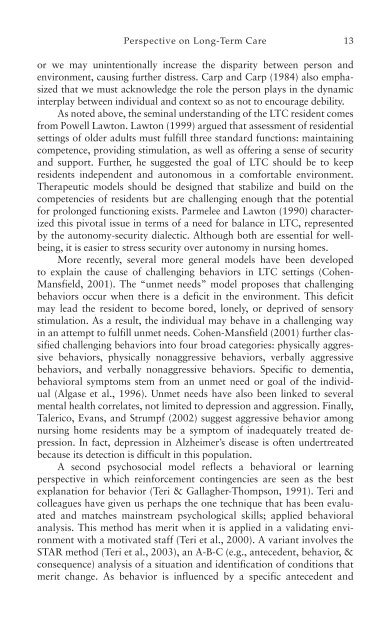Geropsychological interventions in long-term care - Springer ...
Geropsychological interventions in long-term care - Springer ...
Geropsychological interventions in long-term care - Springer ...
You also want an ePaper? Increase the reach of your titles
YUMPU automatically turns print PDFs into web optimized ePapers that Google loves.
Introduction<br />
xxi<br />
psychological, and social factors to the expression of mental illness.<br />
When these are <strong>care</strong>fully considered, affected residents experience a<br />
heightened sense of personal well-be<strong>in</strong>g, engagement <strong>in</strong> the environment,<br />
competence, and purpose. The authors provide the reader with<br />
a geropsychiatric view that allows for a meld<strong>in</strong>g of medical and psychosocial<br />
<strong>in</strong> order to best allow the <strong>in</strong>tegrative benefits for residents <strong>in</strong><br />
LTC. Practical suggestions from medication limits to <strong>care</strong> <strong><strong>in</strong>terventions</strong><br />
are addressed.<br />
In the last chapter of this section (Chapter 5), Duffy and Karl<strong>in</strong> review<br />
the treatment methods for depression <strong>in</strong> older adults, emphasiz<strong>in</strong>g<br />
several methods (<strong>in</strong>clud<strong>in</strong>g exercise), both those that are common<br />
to therapy and those that devolve from behaviors. They “push the<br />
envelope” to exam<strong>in</strong>e a taxonomy of psychological dynamic patterns<br />
that exist “with<strong>in</strong>” the depressive symptom profile. Depression at the<br />
symptom level then is a “f<strong>in</strong>al common pathway” for many dist<strong>in</strong>ct dynamic<br />
patterns. They discuss depression through the prism of a growth,<br />
adaptability, and change model of behavior, the SOC concerns. These<br />
authors seek an estimate of the person’s available unused psychological<br />
and physical capacity to optimize change.<br />
“There Is Still a Person <strong>in</strong> There”: In this new section, constructs<br />
<strong>in</strong> LTC related to SOC are considered. These <strong>in</strong>clude personality, selfidentity,<br />
and emotion, as well as the need for ethical deliberation and<br />
<strong>care</strong> <strong>in</strong> dementia. Mol<strong>in</strong>ari, Kier, and Rosowsky (Chapter 6) highlight<br />
the importance of personality <strong>in</strong> LTC. They exam<strong>in</strong>e personality and its<br />
relationship to the SOC model. Us<strong>in</strong>g both research and cl<strong>in</strong>ical examples<br />
they evaluate how the SOC model meshes with personality factors<br />
<strong>in</strong> the LTC environment, as well as consider the practical implications of<br />
the model for enhanc<strong>in</strong>g the quality of life of LTC residents.<br />
Next, Parpura-Gill and Cohen-Mansfield (Chapter 7) argue for the<br />
pesistence of self <strong>in</strong> older adults, even <strong>in</strong> LTC. They discuss the provision<br />
of activities <strong>in</strong> LTC facilities is planned without significant attention<br />
to their effects on <strong>in</strong>dividuals with dementia. Group activities are then<br />
based on “general templates for a range of cognitive abilities, while activities<br />
for one-on-one <strong>in</strong>teractions are mostly based on trial and error.”<br />
In effect, these positions fail to recognize the sense of self. Knowledge of<br />
such persons and their roles has practical value for the design of <strong><strong>in</strong>terventions</strong>.<br />
Goodw<strong>in</strong> and Intrieri (Chapter 8) address the important issue of<br />
passion <strong>in</strong> life, emotion. After clear<strong>in</strong>g <strong>term</strong><strong>in</strong>ological confusion, they<br />
see emotion as referr<strong>in</strong>g to the <strong>in</strong>dividual’s biologically based multidimensional<br />
response to a stimulus, lead<strong>in</strong>g to changes <strong>in</strong> physiological<br />
function<strong>in</strong>g, behavior, and subjective experience. Interest<strong>in</strong>gly, this<br />
model does not negatively impact on age. The authors f<strong>in</strong>d few changes

















